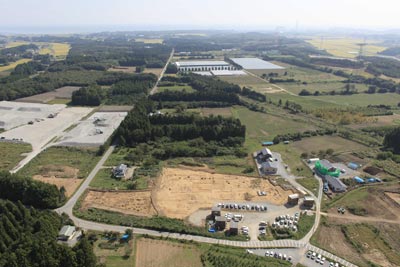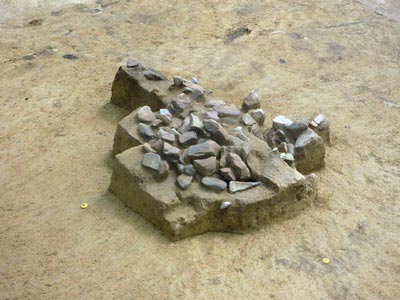Archaeological excavation for reconstruction
ON THE BUILDING OF NEW COMMUNITIES
Conducting excavations
In reconstruction following the Great East Japan Earthquake, particularly in the three prefectures which sustained extreme damage (Iwate, Miyagi, and Fukushima; hereafter, the “Three Northeast Prefectures”), plans for building new communities are being drawn up with a focus on tablelands not touched by tsunami damage.
Tablelands of the northeast region facing the sea on the Pacific side are thought to be where villages of the Jōmon and Ancient periods, and medieval samurai mansions were built, and it is anticipated that such sites (as buried cultural properties) may exist in the proposed locations for mass migration. In such cases, archaeological excavation is conducted. But delay of the reconstruction cannot be allowed. Balancing the smooth recovery from the Great East Japan Earthquake, with proper protection for buried cultural properties, is a huge proposition.
Aiming at flexible execution
In order for buried cultural properties to be protected in proper fashion prior to reconstruction after the earthquake, the Agency for Cultural Affairs first gave notice to the Three Northeast Prefectures and others to be flexible in making decisions about whether or not to excavate. The agency also made it possible to conduct excavations with funds allocated for the recovery. As a result, investigations attending subsidized projects, such as community relocations or the rebuilding of individual homes or small businesses, are essentially covered in their entirety with funds from the national government. In addition, the Agency has decided to dispatch twenty experts to the area starting from April 2012. At present, various means are being considered for increasing this number of personnel, once the reconstruction projects get fully under way. The Agency hopes to continue developing this system for conducting excavations in the future, in close coordination with the Three Northeast Prefectures and the designated city of Sendai.
The role played by cultural properties
At present, archaeological excavations have been conducted throughout the country, showing the existence of unique regional histories and cultures not recorded in documents. Excavated buried cultural properties have played an important role as symbols in the building of uniquely rich identities at the regional and local community levels.
Immediately following the Great Hanshin Earthquake it was feared that excavation, in conjunction with land readjustment projects or the rebuilding of individual homes and apartment buildings, would act as a hindrance to reconstruction efforts.
But archaeological investigations were favorably received, as it was considered necessary for the purpose of recovery to clarify the history of the places people lived. There can be no delay for reconstruction following the Great East Japan Earthquake. While there is need for the excavations to be carried out speedily, they will likely bring forth many discoveries in the process. It is hoped those results will help foster the identities of the people starting their new lives. We can only pray that new communities will be built atop the soil which has produced these unique histories and cultures. (Negita Yoshio)
EXCAVATION IN CONJUNCTION WITH RECONSTRUCTION
Akashiba Site, Shinchi Town, Fukushima Prefecture
An Upper Paleolithic spear point, a rare find for Tōhoku

In the town of Shinchi, located in the northeastern part of Fukushima prefecture, excavation of the Akashiba site was carried out in advance of the construction of the Jōban Expressway, which has come to be regarded as a route for recovery efforts on account of the earthquake.
Akashiba is a site from the Upper Paleolithic (approximately 20,000 BP, uncalibrated), and in the 2011 Fiscal Year investigation about 100 stone tools, including a point for attaching as the tip of a spear, were recovered, and features made with clusters of fist-sized stones were found at five locations.
The spear point, which had been worked at the tip by removing long flakes, resembles stone tools characteristic of the Chūbu and Kantō regions. The stone clusters have from 50 to 350 stones packed together in one spot, and had been exposed to heat with most of the stones burned red or cracked. As the stone tools were few in number and not extensively worked, the location is not thought to have been used for living over extended periods of time, but for short stays during activities such as hunting.
The discovery of such a characteristic spear point, together with the stone clusters, is a rare find.
Many persons who suffered during the Great East Japan Earthquake took part in the excavation. The investigation is being undertaken as an important step in the recovery effort. (Yamamoto Izuru)
 A stone cluster in situ (No. 5, from the northwest) Among the stone clusters, the degree of concentration for this example is high, with 341 stones gathered in a radius of about 1 m. |
 The recovered spear point The long and wide flaked surface at the upper left is called fluting, and is a characteristic of this spear point. This style was prevalent approximately 20,000 years ago in the Chūbu and Kantō regions. Length: 9.9 cm; width: 3.3 cm; thickness: 1.2 cm. |
 Recovered stone tools The main material was a whitish shale. The item at upper left is a flake that was removed in the fluting process. The others are flakes produced in the making of a spear point. For the item at upper left, the length is 7.2 cm, the width 2.2 cm, and the thickness 0.3 cm. |
